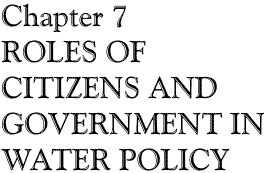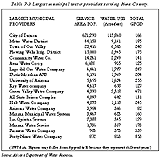
| ch. 7, pp. 100 - 102 |
AWBA also is allowed to negotiate and enter into interstate water banking agreements with California and Nevada, subject to approval by the director of ADWR and subject to other conditions. Such agreements would allow California and/or Nevada to pay to store unused Colorado River water in Central Arizona. This obviously benefits Arizona as more water is added to our aquifers, but the other two Lower Basin states also would gain from the transaction. In later years, those states can “recover” their stored water under a forbearance agreement, through which Arizona would refrain from taking a portion of its entitlement of Colorado River water equal to the amount of water to be recovered. The state that had banked the water could then recover the banked water directly from the river. In effect, by paying to store unused Colorado River water in Arizona, California or Nevada can earn the right to later divert portions of Arizona’s Colorado River allocation from the river.< /P>
The AWBA directly recharged approximately 45,000 acre-feet of excess CAP water in 1997 and approximately 70,000 acre-feet in 1998, of which about 12,000 acre-feet was in Pima County at the Central Avra Valley Recharge Project, the Avra Valley Recharge Project and the Pima Mine Road Recharge Project. The bank also accrued 149,000 in water storage credits for in-lieu “recharge,” none of which occurred in Pima County. Central Arizona Groundwater Replenishment District In 1993, the Arizona Legislature passed a law that provides an alternative method for subdivisions and water providers to meet the rules requiring a demonstrated 100-year supply of water. Entities that couldn’t otherwise demonstrate an adequate physical supply can pay the Central Arizona Groundwater Replenishment District (CAGRD) a fee for the groundwater that the subdivision or water provider is “mining.” The CAGRD then takes responsibility for acquiring and recharging water to offset the mined groundwater. Since “replacement” water does not have to be recharged in the same location as the withdrawal, localized groundwater declines may not be prevented by the arrangement. The overall management goal of safe yield, however, is furthered. Under CAGRD the fees paid are the same (per unit volume) for each of the contributing “members.” Members that are water providers pay the fee directly to CAGRD. In the case of certain subdivisions, each lot owner is a member and the individual pays in the form of an assessment on the property tax bill. One of the consequences of this is that the costs associated with an “assured” water supply are not borne directly by developers. This is one factor for the popularity of the CAGRD option. To date, approximately 115 subdivisions and eight water providers have applied for, or obtained, membership in the CAGRD. In 1987, the Legislature enacted a law restricting the use of surface water or potable groundwater in artificial lakes and ponds in AMAs. A new lake cannot exceed 12,320 sq. ft. — the size of an Olympic-sized pool — unless filled with wastewater or poor quality groundwater. Lakes built before 1987 are exempted, as are lakes in public parks. The size of residential swimming pools also is limited to Olympic size, although the number of pools is not limited.
In the 1970s, Tucson Water began buying farmland in the Avra Valley to obtain water rights in the area. Once the courts determined the arrangement was legal under certain conditions, Tucson considered Avra Valley groundwater an important part of its water supply. In the 1980s, other cities went even farther afield in search of water, to rural areas remote from urban centers. For example, Scottsdale bought land along the Bill Williams River in western Arizona. Some people in rural areas became concerned about losing water supplies and property tax base critical for their survival. In response, the Legislature passed a law limiting new transfers of water from non-AMAs. Because of the law, Tucson is not able to import water from outside the TAMA, such as from the San Pedro River. Two federal laws that have some impact on water decisions are described briefly below, although they are not primarily water-related.
National Environmental Protection Act The National Environmental Protection Act (NEPA) is intended to ensure that significant projects done by the federal government or that use any federal subsidies do not cause environmental damage in the process. Provisions do not apply to private, nongovernmental projects unless they have a federal component such as a housing development that involves federal loan guarantees. When an eligible project is planned, an Environmental Assessment (EA) must be conducted. If this assessment does not indicate that environmental problems are anticipated, the public has the right to comment and either approve or request a more detailed Environmental Impact Statement (EIS). Other federal agencies such as U.S. Fish and Wildlife Service must be given the opportunity to comment on matters under their jurisdiction. The public has the right to comment on the EIS and a public hearing must be held. If troublesome issues arise, a mitigation plan is developed.
|



